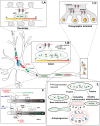Axonal Transport and Mitochondrial Function in Neurons
- PMID: 31447650
- PMCID: PMC6696875
- DOI: 10.3389/fncel.2019.00373
Axonal Transport and Mitochondrial Function in Neurons
Abstract
The complex and elaborate architecture of a neuron poses a great challenge to the cellular machinery which localizes proteins and organelles, such as mitochondria, to necessary locations. Proper mitochondrial localization in neurons is particularly important as this organelle provides energy and metabolites essential to form and maintain functional neural connections. Consequently, maintenance of a healthy pool of mitochondria and removal of damaged organelles are essential for neuronal homeostasis. Long distance transport of the organelle itself as well as components necessary for maintaining mitochondria in distal compartments are important for a constant supply of healthy mitochondria at the right time and place. Accordingly, many neurodegenerative diseases have been associated with mitochondrial abnormalities. Here, we review our current understanding on transport-dependent mechanisms that regulate mitochondrial replenishment. We focus on axonal transport and import of mRNAs and proteins destined for mitochondria as well as mitochondrial fusion and fission to maintain mitochondrial homeostasis in distal compartments of the neuron.
Keywords: axonal transport; dynein; kinesin; mitochondria; mitochondrial dynamics; neurodegenerative disease.
Figures

Similar articles
-
Decreased anterograde transport coupled with sustained retrograde transport contributes to reduced axonal mitochondrial density in tauopathy neurons.Front Mol Neurosci. 2022 Sep 30;15:927195. doi: 10.3389/fnmol.2022.927195. eCollection 2022. Front Mol Neurosci. 2022. PMID: 36245925 Free PMC article.
-
Mitostasis in Neurons: Maintaining Mitochondria in an Extended Cellular Architecture.Neuron. 2017 Nov 1;96(3):651-666. doi: 10.1016/j.neuron.2017.09.055. Neuron. 2017. PMID: 29096078 Free PMC article. Review.
-
Mitofusin 2 Sustains the Axonal Mitochondrial Network to Support Presynaptic Ca2+ Homeostasis and the Synaptic Vesicle Cycle in Rat Hippocampal Axons.J Neurosci. 2023 May 10;43(19):3421-3438. doi: 10.1523/JNEUROSCI.1356-22.2023. Epub 2023 Mar 30. J Neurosci. 2023. PMID: 36997314 Free PMC article.
-
Regulation of mitochondrial transport in neurons.Exp Cell Res. 2015 May 15;334(1):35-44. doi: 10.1016/j.yexcr.2015.01.004. Epub 2015 Jan 19. Exp Cell Res. 2015. PMID: 25612908 Free PMC article. Review.
-
Miro sculpts mitochondrial dynamics in neuronal health and disease.Neurobiol Dis. 2016 Jun;90:27-34. doi: 10.1016/j.nbd.2015.12.008. Epub 2015 Dec 19. Neurobiol Dis. 2016. PMID: 26707701 Review.
Cited by
-
Mitochondrial support and local translation of mitochondrial proteins in synaptic plasticity and function.Histol Histopathol. 2021 Oct;36(10):1007-1019. doi: 10.14670/HH-18-345. Epub 2021 May 25. Histol Histopathol. 2021. PMID: 34032272 Review.
-
Interactions of amyloidogenic proteins with mitochondrial protein import machinery in aging-related neurodegenerative diseases.Front Physiol. 2023 Nov 2;14:1263420. doi: 10.3389/fphys.2023.1263420. eCollection 2023. Front Physiol. 2023. PMID: 38028797 Free PMC article. Review.
-
Analysis of shared underlying mechanism in neurodegenerative disease.Front Aging Neurosci. 2022 Nov 29;14:1006089. doi: 10.3389/fnagi.2022.1006089. eCollection 2022. Front Aging Neurosci. 2022. PMID: 36523957 Free PMC article. Review.
-
Mitochondrial Quality Control Strategies: Potential Therapeutic Targets for Neurodegenerative Diseases?Front Neurosci. 2021 Nov 12;15:746873. doi: 10.3389/fnins.2021.746873. eCollection 2021. Front Neurosci. 2021. PMID: 34867159 Free PMC article. Review.
-
Longitudinal in vivo metabolic labeling reveals tissue-specific mitochondrial proteome turnover rates and proteins selectively altered by parkin deficiency.Sci Rep. 2023 Jul 14;13(1):11414. doi: 10.1038/s41598-023-38484-0. Sci Rep. 2023. PMID: 37452120 Free PMC article.
References
-
- Aschrafi A., Schwechter A. D., Mameza M. G., Natera-Naranjo O., Gioio A. E., Kaplan B. B. (2008). MicroRNA-338 regulates local cytochrome c oxidase IV mRNA levels and oxidative phosphorylation in the axons of sympathetic neurons. J. Neurosci. 28 12581–12590. 10.1523/JNEUROSCI.3338-08.2008 - DOI - PMC - PubMed
Publication types
LinkOut - more resources
Full Text Sources
Other Literature Sources

